Power Electronics and Control Techniques for Maximum Energy Harvesting in Photovoltaic Systems Industrial Electronics Series
Auteurs : Femia Nicola, Petrone Giovanni, Spagnuolo Giovanni, Vitelli Massimo

Incentives provided by European governments have resulted in the rapid growth of the photovoltaic (PV) market. Many PV modules are now commercially available, and there are a number of power electronic systems for processing the electrical power produced by PV systems, especially for grid-connected applications. Filling a gap in the literature, Power Electronics and Control Techniques for Maximum Energy Harvesting in Photovoltaic Systems brings together research on control circuits, systems, and techniques dedicated to the maximization of the electrical power produced by a photovoltaic (PV) source.
Tools to Help You Improve the Efficiency of Photovoltaic Systems
The book supplies an overview of recent improvements in connecting PV systems to the grid and highlights various solutions that can be used as a starting point for further research and development. It begins with a review of methods for modeling a PV array working in uniform and mismatched conditions. The book then discusses several ways to achieve the best maximum power point tracking (MPPT) performance. A chapter focuses on MPPT efficiency, examining the design of the parameters that affect algorithm performance. The authors also address the maximization of the energy harvested in mismatched conditions, in terms of both power architecture and control algorithms, and discuss the distributed MPPT approach. The final chapter details the design of DC/DC converters, which usually perform the MPPT function, with special emphasis on their energy efficiency.
Get Insights from the Experts on How to Effectively Implement MPPT
Written by well-known researchers in the field of photovoltaic systems, this book tackles state-of-the-art issues related to how to extract the maximum electrical power from photovoltaic arrays under any weather condition. Featuring a wealth of examples and illustrations, it offers practical guidance for researchers and industry professionals who want to implement MPPT in photovoltaic systems.
PV Modeling. Maximum Power Point Tracking. MPPT Efficiency: Noise Sources and Methods for Reducing Their Effects. Distributed Maximum Power Point Tracking of Photovoltaic Arrays. Design of High-Energy-Efficiency Power Converters for PV MPPT Applications.
Nicola Femia is a full professor of electrotechnics at the University of Salerno, where he teaches circuit theory and power electronics and leads the Power Electronics and Renewable Sources Laboratory. He has been responsible for research and education projects in collaboration with several industries, including Magnetek, National Semiconductor, STMicroelectronics, PowerOne, and Texas Instruments. He is co-author of more than 140 scientific papers published in international journals and in the proceedings of international conferences. He is co-author of five patents regarding control techniques and power converters for photovoltaic applications.
Giovanni Petrone is an assistant professor in the Department of Electronic Engineering and Computer Science at the University of Salerno, where he teaches electrotechnics and power electronic circuits for renewable energy sources. He is involved in several research projects with international companies and institutions and has also assumed responsibility for some Italian research projects supported by public funds. He is co-author of five patents and several scientific papers published in international journals and in the proceedings of international symposia.
Giovanni Spagnuolo is an associate professor of electrical engineering at the University of Salerno. He is the project leader of two European projects Leonardo Da Vinci and FP7 and one PRIN 2008 project financed by the Italian Ministry of University and of Scientific and Technological Research (MURST), and he is the coordinator of research contracts financed by National Semiconductors Corporation, Matrix S.r.l., and Bitron Industrie S.p.A. He is co-author of six patents and the author or co-author of more than 140 papers published in international journals and in the proceedings of international conferences. He is editor of the IEEE Journal of Photovoltaics and associate editor of the IEE
Date de parution : 01-2013
15.6x23.4 cm
Disponible chez l'éditeur (délai d'approvisionnement : 15 jours).
Prix indicatif 160,25 €
Ajouter au panierThèmes de Power Electronics and Control Techniques for Maximum... :
Mots-clés :
DC Converter; maximum power point tracking (MPPT); MPPT Controller; distributed MPPT; MPPT Efficiency; MPPT Technique; PV system design; MPPT Algorithm; PV power system design; Switching Converter; power control for renewable energy systems; PV Module; PV power electronics; Boost Converter; photovoltaic power electronics; Global MPP; power electronics for PV systems; Irradiance Variation; high-efficiency power converters for photovoltaic applications; MPPT; Irradiance Level; Ds Max; MPPT Converter; Equivalent Circuit; MPPT Method; PV Current; PV Source; Bypass Diode; Switching Losses; PV System; MPPT Strategy; PV Voltage; MPPT Performance; Feasibility Map



